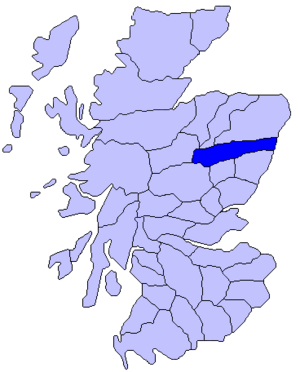Earl of Mar facts for kids
Quick facts for kids Earldom of Mar |
|
|---|---|
| Creation date | 1404 (first creation, as ruled by Parliament) 1459 (third creation) 1483 (fourth creation) 1486 (fifth creation) 1562 (sixth creation) 1565 (seventh creation) |
| Monarch | James II (first creation, as ruled by Parliament) James II(third creation) James II (fourth creation) James III (fifth creation) Mary (sixth creation) Mary (seventh creation) |
| Peerage | Peerage of Scotland |
| First holder | Ruadrí, Earl of Mar |
| Present holder | Margaret of Mar, 31st Countess of Mar (first creation) James Erskine, 14th Earl of Mar and 16th Earl of Kellie (seventh creation) |
| Extinction date | 1479 (third creation) 1483 (fourth creation) 1503 (fifth creation) 1570 (sixth creation) |
| Former seat(s) | Mar's Wark, Kildrummy Castle and Doune of Invernochty |
The Earldom of Mar is a very old and important title in Scotland. It's a special rank given to nobles, like a Duke or a Count. Right now, there are actually two different Earldoms of Mar! This happened because of a big disagreement long ago.
The first Earldom of Mar is currently held by Margaret of Mar, 31st Countess of Mar. She is also a clan chief for Clan Mar. The other Earldom, which was created later, is held by James Erskine, 14th Earl of Mar and 16th Earl of Kellie. He is the clan chief of Clan Erskine.
The Earldom of Mar is one of Scotland's oldest titles. The first known Earl was Ruadrí, who lived around 1128. Some stories even mention an Earl of Mar at the Battle of Clontarf in 1014! Over time, the title was taken by King James II in 1435. He then gave it to some of his children, but they didn't have heirs to pass it on to.
Later, in 1562, the title was given to James Stewart, who was the son of King James V. But he lost the title after a rebellion in 1565. The title was then given to John Erskine, whose family was connected to the original earls.
In 1866, the Earl at that time died without children. This caused a big problem: who should inherit the title? Should it go to his closest male relative (called an heir male) or to his closest relative overall (called an heir general)? This question led to two different decisions by the House of Lords in Britain, which is why there are now two Earldoms of Mar.
In 1875, the House of Lords decided that the earldom given to John Erskine in 1565 was a brand new title, not a continuation of the old one. They said it should only pass to male heirs. But in 1885, a new law called the Earldom of Mar Restitution Act was passed. This law said that the very first Earldom of Mar still existed. It declared that this ancient title belonged to the "heir general" of the original earls.
Many Earls of Mar have been important figures in Scottish history. For example, John Erskine (who died in 1572) was a leader of Scotland after Mary, Queen of Scots stepped down from the throne. Another famous Earl, John Erskine (1675–1732), was a commander who had to escape to France.
Contents
History of the Earldom of Mar
The Earldom of Mar gets its name from Mar, an old region in Scotland. This area stretched west from Aberdeen along the River Dee. It went past Braemar (which means "upper Mar") all the way to the Mar Lodge Estate. Over time, Mar grew north past the River Don. It eventually became the larger region of Marr, which then joined with another area called Buchan to form the county of Aberdeenshire.
Early Earls: 9th to 14th Centuries
The first known leader of Mar was Ruadrí, who was active around 1131. His name is found in an old book called the Book of Deer. Some historical records mention even earlier leaders, like Muirchertach and Gartnait. These names appear in old documents from the time of King Máel Coluim III and King Alexander I.
There are also old Irish stories that say Domnall mac Eimín meic Cainnig, a leader from Mar, died in the famous Battle of Clontarf in 1014. This battle was fought alongside Brian Boru, a famous Irish king.
The region of Mar covered a large part of what is now Aberdeenshire. It stretched from north of the River Don down to the Mounth hills. The main strongholds or castles of the Mar leaders were at Migvie and Doune of Invernochty.
By the 13th century, the Earls of Mar were recognized as some of "the seven earls of Scotland." This meant they were among the most powerful nobles in the country. In the late 1300s, Earl Thomas died without children. The earldom then passed to his daughter Margaret. She was married to William, Earl of Douglas.
The 15th Century and Royal Control

A later Countess, Isabel Douglas, Countess of Mar, was alone at Kildrummy Castle. A man named Alexander Stewart attacked the castle. He forced Isabel to marry him and sign a document in 1404. This document gave him the earldom. Isabel later tried to take it back, but when she married him, she gave him the earldom for his lifetime. The King agreed to this.
In 1426, Alexander Stewart gave up the title so the King could give him a new, more official one. The King did this, but he added a rule: when Alexander died, the earldom and its lands would go back to the Crown (the King).
When Alexander died in 1435, a noble named Robert, Lord Erskine, claimed the title. But King James II said the lands belonged to the Crown because of the earlier rule. This argument continued for many years. Finally, in 1457, King James II won a court case that said the lands were indeed his.
After that, King James II gave the title to his son John. But John died in 1479 without children. The title was then given to James's other son, Alexander. However, Alexander lost the title because he made alliances with the English, which was seen as treason.
In 1486, King James III made his son John the Earl of Mar. But when this John died in 1503, the title ended again.
The 16th to 18th Centuries
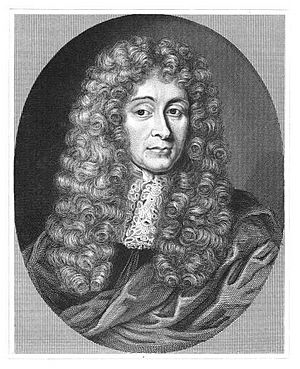
The title was created again in 1562 for James, Earl of Moray. He was the son of King James V. But he also didn't have a suitable heir. James rebelled against Mary, Queen of Scots in 1565. Because of this, Queen Mary gave the Earldom of Mar to John, Lord Erskine. John was a descendant of the ancient Earls of Mar.
His son, also named John, managed to get back the Mar family lands. These lands had been taken by the Crown while his family was out of power. A later John Erskine (the 23rd Earl) was punished for rebellion in 1716. This meant his title was taken away for over a century.
The 19th Century and the Two Earldoms
| Mar Peerage Restoration Act 1824 | |
|---|---|
| Act of Parliament | |
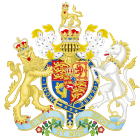
|
|
| Long title | An act for exhibiting a Bill for the Restoration of John Francis Erskine of Mar. |
| Citation | 5 Geo. 4. c. 59 |
| Dates | |
| Royal assent | 9 June 1824 |
In 1824, the Earldom was given back by a special law to John Francis Erskine. He was the heir of the Earl who had lost the title. His grandson later also claimed another earldom, the Earldom of Kellie, in 1835.
When the 26th Earl of Mar and 11th Earl of Kellie died in 1866, he had no children. The Earldom of Kellie and the family's lands went to his cousin, Walter Erskine. Everyone thought the Earldom of Mar would go to John Francis Goodeve, the late Earl's nephew. Goodeve even changed his name to Goodeve Erskine.
However, the Earl of Kellie argued that the Earldom of Mar should be his. He died before his claim could be heard. His son, the 13th Earl of Kellie, continued the claim. The House of Lords looked into it.
The Earl of Kellie's side argued that the original Earldom of Mar was tied to land. They said that when the land was taken by the Crown, the earldom ended. They also said that the 1565 grant was a completely new title, not a return of the old one. Since the original document for the 1565 grant was missing, they believed it should pass only to male heirs. This would make the Earl of Kellie the rightful owner.
John Goodeve Erskine disagreed. He argued that the King taking the lands was unfair. He said the 1565 grant was a restoration of the old earldom. Since the old earldom could pass to any heir, male or female, he believed he was the rightful heir.
In 1875, the House of Lords decided that the Earldom of Mar was indeed a new title created in 1565. They said it should only pass to male heirs. So, they ruled that it belonged to the Earl of Kellie. The head of the House of Lords said this decision was "final."
| Earldom of Mar Restitution Act 1885 | |
|---|---|
| Act of Parliament | |

|
|
| Long title | An Act for restitution of the ancient dignity and title of Earl of Mar. |
| Citation | 48 & 49 Vict. c. 48 |
| Dates | |
| Royal assent | 6 August 1885 |
However, many people felt the Lords had made the wrong decision. A new law was brought to Parliament to allow Goodeve Erskine to have the title. This law passed easily. The Earldom of Mar Restitution Act 1885 stated that because there were doubts about the 1565 creation, there would now be two Earldoms of Mar.
The Earldom created in 1565 would be held by the Earl of Kellie. But the ancient earldom was declared to still exist and was given to John Goodeve Erskine. To decide which Earl was more important, it was agreed that Goodeve Erskine's earldom would be treated as if it was created in 1404.
Current Titleholders
Earldom of Mar, First Creation (1404)
| Eardom of Mar (1st creation) |
|
|---|---|
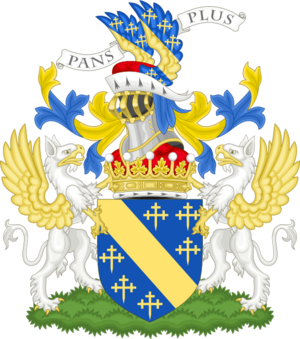 |
|
| Creation date | c. 1014 |
| Monarch | King Malcolm II |
| Peerage | Peerage of Scotland |
| First holder | Ruadrí, Earl of Mar |
| Present holder | Margaret of Mar, 31st Countess of Mar |
| Heir presumptive | Susan of Mar, Mistress of Mar |
| Remainder to | heirs general of the body of the grantee |
| Subsidiary titles | Lord Garioch (1320) |
- The current holder is Margaret of Mar, 31st Countess of Mar (born 1940).
- Her likely heir is her daughter, Susan Helen of Mar, Mistress of Mar (born 1963).
Earldom of Mar, Seventh Creation (1565)
| Earldom of Mar (seventh creation) held with Earldom of Kellie |
|
|---|---|
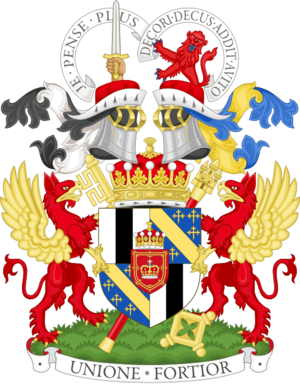 |
|
| Creation date | 1565 |
| Monarch | Mary, Queen of Scots |
| Peerage | Peerage of Scotland |
| First holder | John Erskine, 1st and 18th Earl of Mar |
| Present holder | James Erskine, 14th Earl of Mar |
| Heir presumptive | Hon. Alexander David Erskine |
| Remainder to | heirs male of the body of the grantee |
| Subsidiary titles | Viscount of Fentoun, Lord Erskine, Lord Erskine of Dirleton |
- The current holder is James Thorne Erskine, 14th Earl of Mar and 16th Earl of Kellie (born 1949).
- His likely heir is his brother, the Hon. Alexander David Erskine, Master of Mar and Kellie (born 1952).
See also


